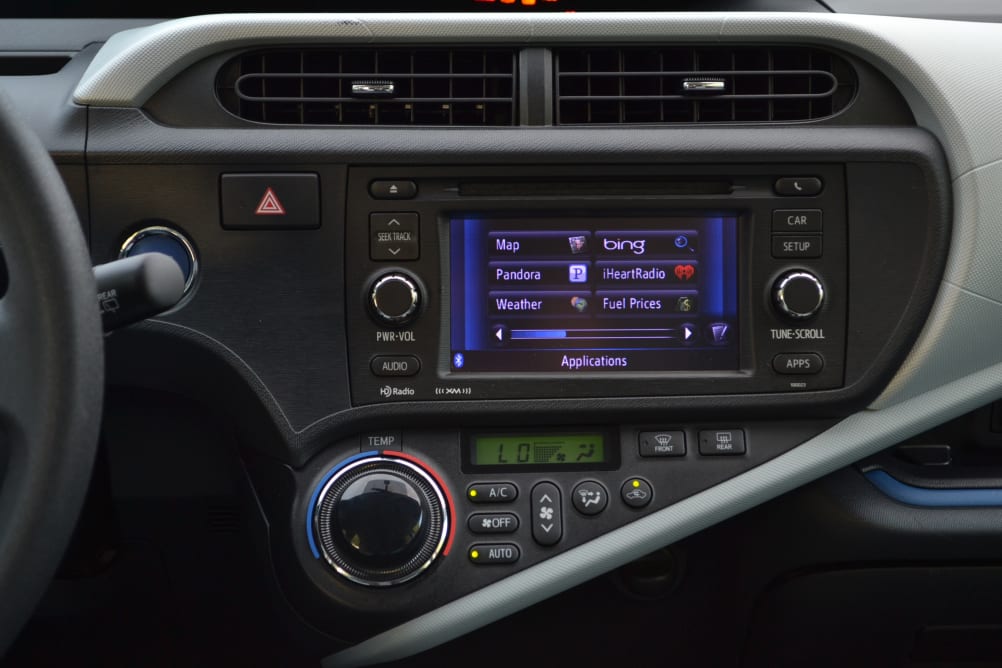Pros
Cons
Introduction
The Prius family has grown—and shrunk—into three distinct models.
The problem is, Toyota didn't create an entry-level Prius. Instead, they hybridized the Toyota Yaris—a budget-oriented car with looks and handling to match. Though the C is smaller than a standard Prius, it gets similar fuel economy to its bigger brother (a still-commendable 50 MPG combined) thanks to a smaller, cheaper battery and offers no additional driving pleasure. About the only advantage the Prius C offers is a starting price of just under $19,000—about $5,000 less than a conventional Prius. And like a single issue voter, the C keeps hammering home that lone talking point, hoping that potential buyers overlook its otherwise questionable record.
Tech & Entertainment
Toyota has one of the most straightforward app-enable infotainment systems on the market.
The Prius C has Toyota's new Entune smartphone connectivity package, which allows users to link their smartphone's data connection over Bluetooth using a downloadable app. Because it requires the Entune app to be downloaded and running, it's clunkier than options from, say, Audi—which just rely on a phone's data connection and let the car's infotainment system do the heavy lifting. But it does give access to Pandora, OpenTable, Yelp and other apps.
One or the best is Microsoft's Bing search engine, which allows the user to use voice recognition to find and enter a destination in the navigation system in less time than it would take to type it on the touch screen.
Part of the magic is that Entune is a good listener: It waits for you to give a whole address, so it can parse out the parts that it's heard and fill in the rest using what information it has. For example, if you're going to 393 Main Street in Whoville, Massachusetts and Entune can only make out "393 -ain St., -ville, Massachusetts," it'll search for all the "-ville's" with "-ain" streets in the state in order to make a match.
We put Entune to the test against Toyota's stock navigation system in a 2012 Prius Plug-In, and Entune emerged the clear winner:
We did have some issues getting the car to connect with Entune over Bluetooth -- and from the reviews in the iTunes App Store, it looks like we weren't the only ones. We finally resorted to plugging in our iPhone. Once plugged in, we were able to run apps such as Bing, Pandora, Opentable and iHeartRadio. Even with a solid 3G connection, though, they were far from lightning-fast.
{{photo_gallery "tech"}}
Design
We aren't fooled by this disguise
We drove a Prius C Three —the second highest trim level—which was fitted with the optional touch screen navigation. The interior initially impressed, with modern design and plenty of clean lines, but we found plenty to complain about after a week. The thin seats lacked support, touch points felt flimsy and some interior parts were already visibly worn even though the car had fewer than 10,000 miles on the odometer. It reminded us of a cheaply renovated house: Sure, everything looks great in those photos on the real estate agent's website, but it's all for show.
Toyota has clearly worked hard to graft design elements of the mainstream Prius onto the C as if to convince customers that yes, indeed, this is the real thing. Unfortunately, the result looks like a Yaris wearing a cheaply made Prius costume.
{{photo_gallery "design"}}
Driving Experience
It handles like an economy car, so no surprises there...
Compared to its older brother, you'd think that the Prius C's short wheelbase and relatively light weight would make it a little tighter, a little firmer and a little more engaging to drive, but you'd be wrong. The lack of power and soupy handling make city streets just that much meaner, and highways not so carefree. And yes, the usual hybrid caveat applies: the C suffers from grabby, nonlinear brakes that take a few days to get used to.
While the mainstream Prius is no Lotus Elise, at least the larger car is inoffensive, riding like a slightly quirkier Camry. The C is clearly an economy car through and through, even down to how it handles. It's unfortunate, but perhaps the most engaging thing about driving the Prius C is keeping an eye on that digital dashboard and trying to maximize fuel economy
City-dwellers may not mind, though, since Prius C is extremely easy to park, and its large rear window and stubby rear end make for excellent visibility. There's no rear-view camera, and you won't need one. We had no trouble fitting this car into tight spaces all over the streets of Boston and Cambridge.
Conclusion
On paper, the Prius C seemed like such a good idea: a less expensive Toyota hybrid for the masses that still offered high style and high tech. Unfortunately, our week spent with the Prius C told a different story. While we welcomed its low price point, we found the car to be a poor excuse for a Prius. That's likely because it's based on the smaller, cheaper Yaris platform. To save even more money, Toyota put in a less-powerful drivetrain with a cheaper battery. That gives the much smaller C roughly the same fuel economy as its bigger brother.
Trim Levels
Powertrain
The Prius C comes with front-wheel drive. Like any car with traction control, Toyota's Hybrid Synergy Drive cuts off power to the front wheels when they start to spin. However, in order to prevent the hybrid's electric motor from burning out, there's no way to punch the gas and smoke the tires anyway. It means you may have some trouble getting your car freed if you end up stuck in the snow with all-season tires. We recommend all drivers buy winter tires if they live in an area that frequently sees snow, ice or even just low temperatures.
Safety
Fuel Economy
Though it's smaller than the mainstream Prius, the C's lesser footprint doesn't mean better fuel economy. That's because the C relies on battery with fewer cells. Therefore, drivers should expect around 50 MPG in mixed city and highway traffic. That's still extremely impressive when compared to most other cars on the road—but the C's focus is on MSRP, not MPG.
Meet the tester
Keith was the Editor in Chief of Reviewed's appliance and automotive sites. His work has appeared in publications such as Wired, Car & Driver, and CityLab.
Checking our work.
Our team is here to help you buy the best stuff and love what you own. Our writers, editors, and experts obsess over the products we cover to make sure you're confident and satisfied. Have a different opinion about something we recommend? Email us and we'll compare notes.
Shoot us an email

